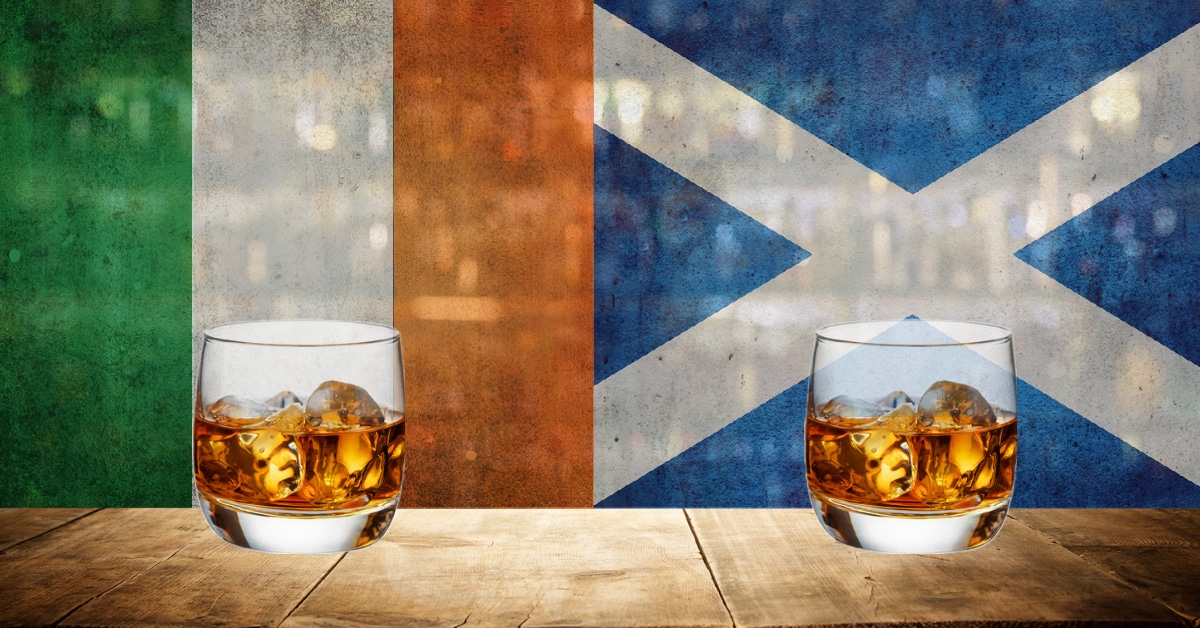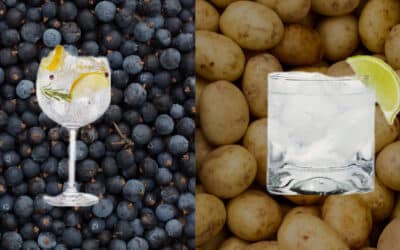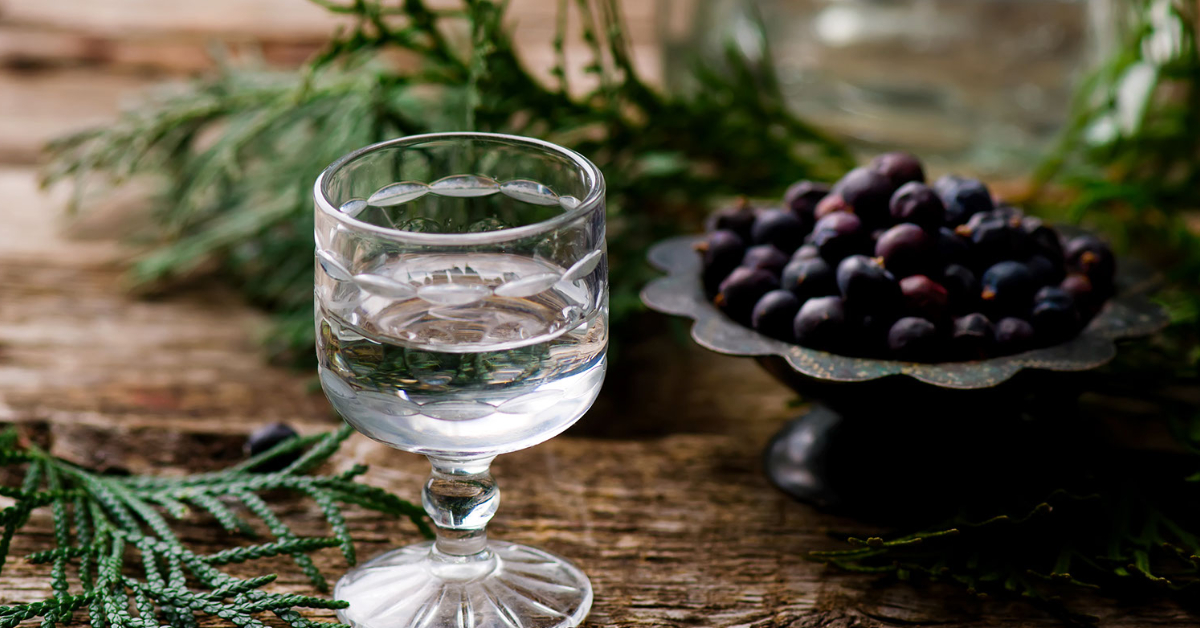Irish Whiskey vs Scotch: What’s the Difference?

sIreland and Scotland have been producing whiskey for centuries. Even though they’re neighboring countries in the ideal geography for whiskey production, there are some fundamental differences in their approach. Spirits enthusiasts have become passionate about their preference in the Irish whiskey vs Scotch debate. For newcomers, understanding the differences between Irish whiskey and Scotch can help you discover your new favorite whiskey.
Whiskey vs Whisky
Uisce Beatha, the water of life, known around the world as whiskey. Or is it whisky? The general rule of thumb is that if whiskey is produced in Ireland, it’s spelled with an “e.” If the whisky is made in Scotland, it’s spelled without the “e.” This subtle distinction can help you quickly differentiate between Scotch and Irish whiskey products. A trick to help you remember is that there’s an “e” in Ireland, and there’s no “e” in Scotland.
Differences Between Irish Whiskey and Scotch Production Processes
It’s the little things that set Irish whiskey and Scotch apart in big ways. Nuances between how Scotch and Irish whiskey are made significantly impact the final product. From fermentation to distillation to maturation, we’ll break down the production processes of each spirit and what sets them apart.
Malted vs Unmalted Barley
One of the most noticeable differences in the production of Irish whiskey and Scotch is the use of malted barley. Malting is the process of soaking grain in water and then allowing it to germinate. After the germination process, the malt is kilned to stop growing further. Peat is frequently used in the malt kilning process for Scotch whisky but is rarely used in Irish whiskey production. Kilning activates enzymes in the grain that convert starches into fermentable sugars. The resulting yeast can then turn into alcohol.
Single malt Scotch must be made of malted barley. Likewise, single malt Irish whiskey is also made with malted barley. Still, other types of Irish whiskey can be made from a mix of unmalted and malted barley. The use of unmalted barley stems from an Irish workaround solution for evading the King’s tax law.
In 1785, the King of England authorized a tax on malted barley in British-controlled Ireland. However, cunning Irish distillers combined malted and unmalted barley so they would only be liable to pay a fraction of the taxes. This style became known as Single Pot Still whiskey.
Today, Irish law states that Single Pot Still whiskey must contain a minimum of 30 percent malted barley and 30 percent unmalted barley in the mash bill. The use of unmalted barley gives Irish whiskey a complex and distinct flavor that sets it apart from Scotch whisky.
Triple vs Double Distillation
The next big difference between Scotch and Irish whiskey is the number of times the spirit is distilled. Most Scotch whisky is distilled twice, while Irish whiskey is typically distilled three times. Distilling whiskey one extra time yields a smoother final product. The additional distillation gives Irish whiskey a lighter flavor that feels smoother to sip.
Copper Pot Still vs Column Still
Using a copper pot versus a column still in the distillation process also impacts the final product. For example, malt whiskeys are distilled in traditional copper pot stills. In contrast, grain whiskeys are typically distilled in industrial column stills. After distilling whiskey, it’s transferred to a barrel, where it matures for a set time to enrich the flavor profile. At this stage, more nuances come into play that create different types of whiskey.
Maturation Process of Irish Whiskey and Scotch
The whiskey cask’s location, size, material type, and maturation length impact the final product. According to law, Irish whiskey and Scotch must be aged for a minimum of three years in casks that do not exceed 700 liters. However, the legal frameworks codified by the United Kingdom and Ireland contain several notable differences.
For a whiskey to be considered Scotch, it must be matured in Scotland. Similarly, whiskey is required to age on the isle of Ireland, in the Republic of Ireland, or Northern Ireland, to be considered Irish whiskey.
Not only does location impact the whiskey’s name, but it also alters the taste. The climate where the barrels are stored impacts the final product. For example, Scotch matured near the coast will have a more distinct flavor due to the salt in the air.
Both spirits can age in any type of wood. Many distillers in Scotland and Ireland recondition ex-bourbon casks for maturation since bourbon laws mandate that only new charred oak barrels are used for its aging process.
Distillers also utilize secondary casks from around the world, including bourbon, rum, sherry, and beer casks. Different flavors are imparted by each type of cask used during the aging process.
The final difference in the maturation process between Irish whiskey and Scotch is the length of time each spirit is aged. According to Irish law, whiskey must be aged for a minimum of three years, but there is no maximum aging limit. In Scotland, on the other hand, Scotch must be aged for a minimum of two years, but it can be aged for up to 30 years or more.
Ultimately, these subtle differences in the Irish whiskey and Scotch production processes hugely impact how the spirits taste.
Irish Whiskey vs Scotch Taste
Irish whiskey is generally light, smooth, and fruity. Scotch has a pronounced smokey flavor due to the peat used in the malting process. However, these are only generalizations. Scotland and Ireland produce various types of whiskeys that run the full flavor gamut.
Types of Scotch vs Irish Whiskey
Now that you’re well-versed in how Irish whiskey and Scotch are made, you’ll notice the seemingly subtle differences when tasting different types of Scotch and Irish whiskeys.
Types of Scotch
Five different types of Scotch are distinguished by their mash bills and the number of distilleries used in the production process.
- Single Malt Scotch Whisky — Must be made from a mash bill of 100 percent malted barley and distilled at a single distillery in Scotland using a copper pot still
- Single Grain Scotch Whisky — Can be made from a mash bill that includes one or more malted or unmalted grains but must be made at a single distillery
- Blended Malt Scotch Whisky — Made from a blend of different single malt whiskies from Scotland’s various regions
- Blended Grain Scotch Whisky — Made from a combination of single grain whiskies from two or more distilleries
- Blended Scotch Whisky — Can be made from a combination of any of the above types of Scotch
Types of Irish Whiskey
Four different types of Irish whiskey are also distinguished by their production process.
- Single Pot Still Irish Whiskey – The only type of whiskey exclusively made in Ireland, it’s made from a mix of malted and unmalted barley, distilled in a pot still, and produced by a single distillery
- Single Malt Irish Whiskey – Made from 100% malted barley and distilled in a traditional copper pot still at a single distillery
- Single Grain Irish Whiskey – Traditionally used in blended whiskey, it’s made from a mix of grains (usually wheat or corn) and distilled in a column still
- Blended Irish Whiskey – Accounting for the majority of Irish whiskey in production, it’s made from a combination of any of the three other types of Irish whiskey
Discover Your Preferred Spirit
As you can see, there are some subtle differences between the production processes of Irish whiskey and Scotch that have a big impact on the taste. The Scottish follow a strict set of rules for making their whisky. However, because of Ireland’s looser restrictions, distillers are allowed to be more creative with their products. This information will not only help you choose your preferred spirit, but it will also help you choose which country to visit on your next vacation. At Kinnitty Castle Spirits, we can help you make both of those decisions. Cheers to your newfound discoveries in the world of whiskey!



